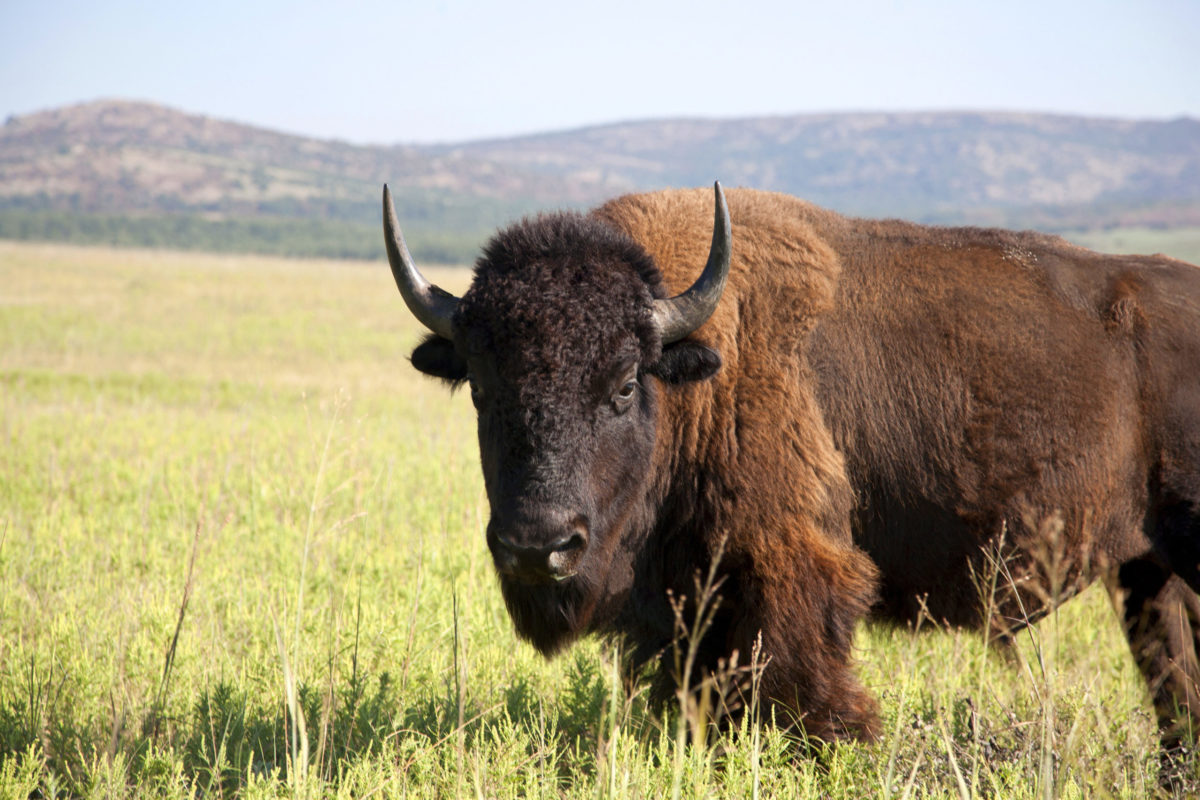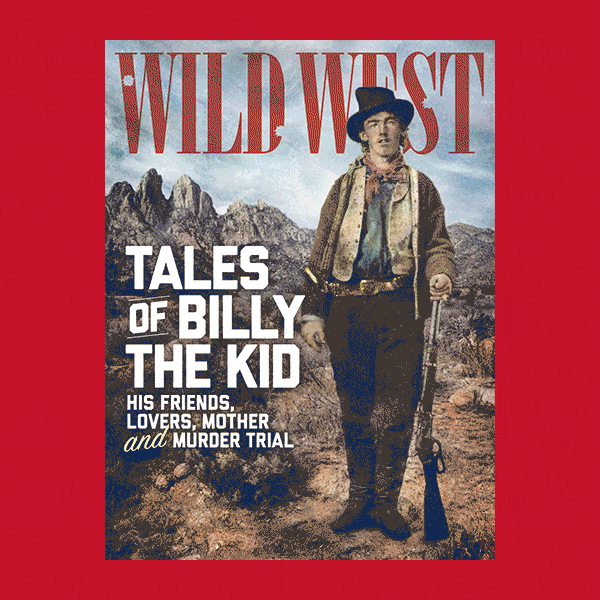Probably no late 19th-century American business venture affected Western settlement as profoundly as the buffalo trade. Even the railroads owed much to the ragged hide hunters; without them it would have been impossible to crisscross the Great Plains with tracks, let alone run trains — on time, anyway — upon them. Yet the bison-hunting business didn’t start with any such ambitions.
For decades white hunters, like the Indians before them, shot the wooly beasts for what they could use or trade: meat for sustenance, tallow for cooking and candles, and hides for the heavy robes that fended off hard prairie winters. The great enterprise buffalo hunting became — the colorful pursuit that made fortunes, spawned legends and all but exterminated a species thought nearly infinite — began almost by chance.
Josiah Wright Mooar left his native Vermont in his teens. In the fall of 1870, he found work in Kansas, shooting the plentiful Plains buffalo for meat—first to feed soldiers stationed at Fort Hays, and then to supply the Atchison, Topeka & Santa Fe crews laying track westward toward Fort Dodge and the ragtag civilian outpost known as Buffalo City.
Mooar’s fortunes, and the buffalo’s, changed forever in late 1871. Though conventional wisdom considered the buffalo’s heavy, tough skin unsuitable for boot or harness leather, an English tannery had decided to give it a go and engaged Leavenworth, Kan., hide and fur dealer William C. Lobenstein to supply 500 hides. Lobenstein turned to hunter-merchants Charles Rath and A.C. “Charlie” Myers, who in turn contracted Mooar and several others to help fill the order.
When Mooar fulfilled his commission, he had 57 leftover hides. Reasoning that American tanneries could make leather as easily as English ones, he shipped the extra skins to his older brother, John Wesley Mooar, in New York City. Josiah sent instructions that John should try to interest “the tanners of New England” in the hides.
He needn’t have bothered; advance word of the novel cargo reached New York, and John was beset by curious onlookers—including several fur traders. He sold the hides nearly on the spot and soon sent his brother an order for 2,000 more. The tanners had discovered that buffalo hide made ideal machinery belting, crucial in the midst of a burgeoning Industrial Age.
“The moment it became known that here was a new industry promising great returns,” Josiah Mooar later said, all manner of men took up the hunter’s profession. What had been mainly a winter trade now became a year-round occupation. Depending on condition, hides brought the hunter anywhere from 50 cents to $1.25 apiece. The boom attracted many whose names—Cody, Tilghman, Masterson, Earp—would later be famous for other exploits. By the fall of 1872, the railroad had reached Buffalo City, by then the hub of the buffalo trade and—thanks to its military neighbor—renamed Dodge City. By winter a chain of camps stretched from Dodge westward into Colorado Territory, each filled with adventurers seeking “buffalo gold.” Among the most successful hunters was Frank H. Mayer, who one day fired his Sharps .40-90 just 62 times to kill 59 buffalo and for the years 1872 and ’73 netted $6,000 in hides.
Hide hunting wasn’t glamorous. “In the beginning,” wrote Colonel Richard Dodge, then commander of Fort Dodge, “every man wanted to shoot. No man wanted to do the other work.” But successful “buffalo running,” as the hunters called it, required an organized approach. The typical outfit comprised one or more freight wagons with teamsters to drive and tend stock, one or two hunters for the actual shooting, skinners to strip hides and stake them out to dry, and a cook. Skinners or cooks also carved meat from the kills and packed it in salt. Contrary to the stereotype, hunters seldom left whole carcasses to rot; millions of pounds of buffalo meat went east with the hides, sold by the hunters for a penny to 3 cents a pound.
Jobs might overlap, but an outfit seldom set out with fewer than a half-dozen men. This was as much for safety as efficiency; the Plains tribes, whose livelihood depended on the bison, naturally took a dim view of what they considered poaching. Resentment increased when, having thinned out the herds roaming Kansas, hunters began moving south and operating in the off-limits Indian Territory.
This practice sparked the June 1874 Second Battle of Adobe Walls, in which a confederation of Plains Indians besieged the Texas Panhandle trading post, hoping to deal a death blow to the white man’s buffalo trade on their lands. The scheme backfired; not only did the Indians lose the fight, their actions mobilized the U.S. Army. Expeditions were mounted, new military posts established, and the hunters now enjoyed limited protection from the U.S. military.
Thus the situation remained, more or less, for the next several years, as the toll on the buffalo continued. By one estimate, their number shrank from more than 12 million in 1871 to fewer than 400,000 by 1880. By 1889 the estimate dropped to a shocking 150. According to Colonel Dodge, “The buffalo melted away like snow before a summer sun.”
Buffalo hunters began looking to other means of support. Many, already invested in wagons and teams, became freighters. Earps and Mastersons became lawmen and gamblers. Still others took up another trade borne of the great slaughter.
It might seem the buffalo had already given the frontier economy its all. But, as The New York Times put it, “Here commerce steps in again to ask for something else; the very last remnant there is left of an annihilated race.” Fields of bones blanketed the prairie, mute evidence of the herds’ former vastness. These forlorn skeletons became a new cash crop. Eastern markets ground them for fertilizer or made buttons from them. Factories refined the calcium phosphate from them to whiten sugar or to make bone china.
Bone pickers earned from $2 to $8 a ton; a large wagon could tote several tons. Railroad sidings once piled with buffalo pelts now became sepulchers of bone—mounds often 15 feet high and twice as wide, stretching as far as a mile. During the peak buffalo hunting years of 1872–74, more than 1,600 tons of bones went east by railroad. By 1883 Dodge City alone had shipped 4,000 tons.
Homesteaders picked bones to make ends meet, providing the perfect return-trip cargo for freighters making remote deliveries. “Farmers and ranchmen,” said The New York Times “when they have nothing else to do, harness up their teams and go to gathering buffalo bones.” Though not as lucrative as buffalo running, bone picking was easier, cleaner and less risky. The enterprise continued into the early decades of the 20th century, though by then many of the bones were no longer of bison, but of Longhorns and other cattle.
The twin buffalo trades were crucial elements to the American economy and westward settlement. The buffalo hunter, perhaps the West’s most colorful entrepreneur, has remained an American icon from the days of the thundering herds. In September 1877 the Dodge City Times published a poetic tribute under the byline Vox Buffalorem. It concludes:
Thank heaven, my boys, for a land which is blest,
With a frontier so boundless and free.
So drink to the hunter and drink to the West,
And pass the “red liquor” to me.






